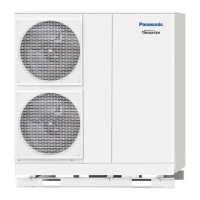97
Aquarea air-to-water heat pumps - Planning and installation manual - 02/2022
Planning
5
ATTENTION
Risk of damage to building or of slipping on the oor
In cooling mode, a temperature drop below dew point can cause condensation of moisture from the
air on the surface of the heat transfer systems. This can damage the building or pose the risk of
slipping on the oor.
► Prevent the temperature from dropping below the dew point by suitable placement of dew
point sensors.
► Alternatively, safely drain the condensate that forms.
► In addition, insulate the pipes concerned to prevent diusion.
5.1.7.1 Cooling with underoor heating
Underoor heating (or any surface embedded heating system) is generally suitable for the cooling
mode, however cannot be operated with very low supply water temperatures, because the level
of comfort drops, and the danger of falling below the dew point arises. In general, therefore, the
surface temperature should be limited to at least 20 °C. If the temperature dierence between
supply and return water temperature (ΔT) is 3 to 4 K, it is possible to achieve a specic cooling
capacity of 30 to 40 W / m². The cooling capacity is inuenced considerably by the pipe distance
and the pipe diameter of the underoor heating as well as the oor covering. In the case of a tiled
oor, the heat transfer is signicantly better than, say, with a carpeted oor, which directly aects
the cooling capacity.
Due to the systemic limits to the cooling capacity of underoor heating, room cooling cannot be
regulated to a xed indoor temperature. However, at least the supply water temperature must be
set to a value that prevents the room temperatur from dropping below dew point.
5.1.7.2 Cooling with fan coils
Fan coils can be operated with very much lower supply water temperatures than underoor
heating. Correspondingly, fan coils allow you to achieve a higher cooling capacity than underoor
heating and also greater comfort due to the type of room climate control. Due to the low supply
water temperatures, which can be obtained when using fan coils for room cooling, the pipe must be
covered by a diusion-proof insulation and the condensate must be drained via a connection pipe
to the house drainage system or to the outside.
5.2 Installation criteria
5.2.1 Acoustics
5.2.1.1 Sound pressure level
Sound is produced when air is made to start vibrating. This vibration widens as a pressure wave
in the air and this way travels from the sound emission source to the eardrum of the human
ear (immission point). Irrespective of the type of sound (language or engine sound), the sound
can be measured as sound pressure. The higher the sound pressure, the louder is the sound
perception. The human ear can perceive a range from 20 x 10
-6
Pa (audible threshold) to 20 Pa
(pain threshold). This range, which corresponds to a ratio of 1:1,000,000, is however not perceived
by the human ear in a linear manner, but a logarithmic one. For this reason, the sound pressure is
also not indicated as pressure but as a sound pressure level in Decibels (dB).
Typical sound situations and thereby occurring sound pressure levels and sound pressures
Sound Sound pressure level in
dB (A)
Sound pressure in μPa Sensitivity
Woods 20 100 Very soft
Library 40 1,000 Soft

